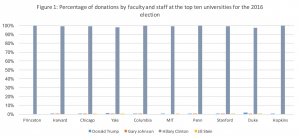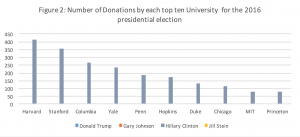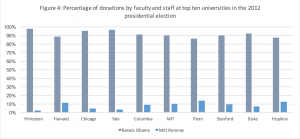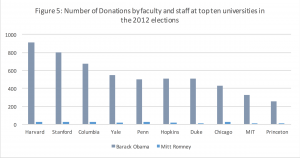Vast majority of faculty and staff members from universities support Hillary Clinton. Donald Trump’s percentage of donations from faculty and staff is on average 0.5 percent of the total amount raised by each university.
There is an extensive literature that discusses the relationship between academia and liberal political orientation. Academics in general tend to be on the left side of the political aisle and the data from presidential election contributions that we collected reinforces this idea. As Election Day looms, our calculations indicate that faculty and staff at the top 100 colleges in the United States lend their support almost entirely to Hillary Clinton.
Looking at political contributions to presidential candidates, we examined which candidates faculty and staff donate to. Interesting results appear when we focus on the 2016 presidential campaign. Looking at the top ten universities (as ranked by U.S. News & World Report), on average 99 percent of the total amount donated by faculty and staff at each university went to Hillary Clinton (see Figure 1). Harvard, Stanford, and Columbia University placed not only at the top as the best colleges in the US but also as the biggest supporters of Hillary Clinton. For example, Harvard’s faculty and staff have raised a total of $443,453 for presidential candidates in this election cycle, with the vast majority ($440,907) raised for Clinton. Yale University, Clinton’s alma mater, has raised a total of $226,411, ranking fifth in terms of donations among the top ten colleges.
Donald Trump, the Republican candidate, has received a total of $2,446 from Harvard’s faculty and staff and a total of $2,700 from those at MIT, the latter representing the largest total donations from faculty and staff at any of the top ten universities. Trump’s percentage of donations from faculty and staff is on average 0.5 percent of the total amount raised by each university, as Figure 1 illustrates.
Among the top ten universities, more than 2,000 university members donated to candidates in the 2016 elections. Clinton held a significant advantage over Trump, not only in overall fundraising, but also in number of donors. Figure 2 shows the number of donors at each of the top ten universities. Harvard, Stanford, and Columbia placed at the top with 420, 357, and 267 donors respectively. In Trump’s case, the largest number of donors came from Harvard, Duke, and MIT–each with four donors.
There is not much difference in support across the top eleven to 100 universities. As shown in Figure 3, on average, faculty and staff support Clinton by 97.5 percent (gray bar). The biggest donations received by Trump came from Wake Forest (19.1 percent) and Methodist University (12.4 percent) both located in North Carolina (see light blue bars). Members of the University of Minnesota Twin Cities and Clemson University donated 13.4 percent and 11.4 percent of their total amount raised to Gary Johnson. By contrast, employees of Brown University, University of Californa Los Angeles (UCLA), New York University (NYU), and University of California Berkeley, among others, gave 100 percent of total funds raised for Clinton.
The disparity between donations to Republicans and Democrats by university faculty and staff is most evident for the 2016 presidential election. In 2012, Barack Obama captured on average 91 percent of total donations raised by members of each university, as shown by Figure 4. Hillary Clinton increased Obama’s numbers by 6.5 percentage points (compare with Figure 1) in 2016. Looking at the top ten colleges, around 652 faculty and staff who contributed to Obama’s general election also contributed to Clinton’s campaign. For example, around 112 of Harvard’s faculty and staff contributed to both campaigns, 95 from Duke University, 84 from MIT, and 84 from John Hopkins University.
The increased percentage in the total amount raised by Clinton is not coming from Romney’s supporters or from an increase in the number of Clinton supporters. No contributors that we could identify in the data switched their donations between parties and in fact fewer individuals contributed to Clinton’s campaign than to Obama’s campaign. Instead, there was a decrease in the number of donors compared to 2012, much more pronounced for Republicans than for Democrats. While 915 faculty and staff at Harvard contributed in the 2012 elections (see Figure 5), only 412 donated to 2016 campaigns (see Figure 2). However, Harvard’s donors contributed more on average in 2016 than 2012 ($955 and $609 per donor respectively). Few staff or faculty at Harvard have contributed to Trump’s 2016 campaign. While four of Harvard’s donors support Trump, twenty-eight supported Romney in the previous presidential election.
Methodology
All calculations were made using data from the Federal Elections Commission (FEC). In particular, we used donation information from itemized individual contributions, PAC, super PAC, and Joint Fundraising Committees. Data includes contributions made by donors who listed any university as their employer. We searched for all possible self-reported employer names. For example, donors self-reported CALTECH as: “CALIFORNIA INST. OF TECHNOLOGY,” “CAL TECH,” “CALIFORNIA INSTITUTE OF TECHNOLOGY,” “CALIFORNIA TECH,” “CALIFORNIA TECHNOLOGY,” “CALTECH,” “JPL/CAL TECH,” and “JPL/CALTECH.” We do not include non-itemized contributions, given that contribution committees and campaigns do not have to disclose their in
formation.
The data was not refined based on occupation. For example, the data was not sorted by donations made solely by “professors,” other staff members are included.











